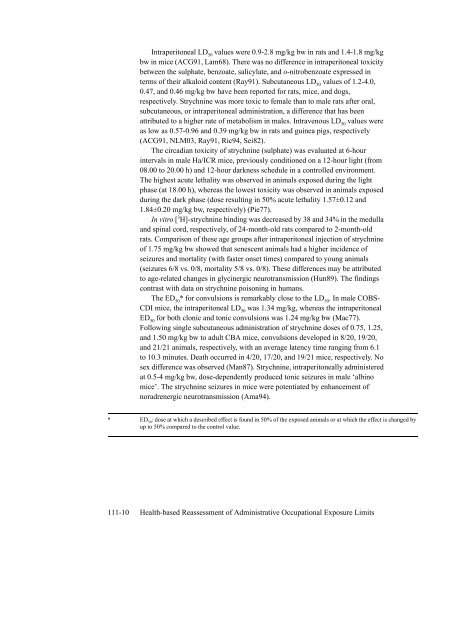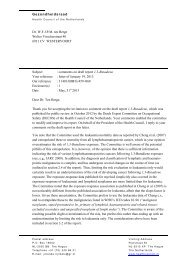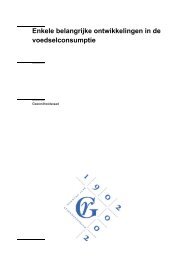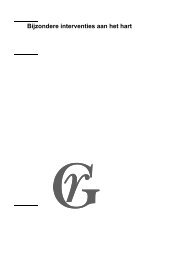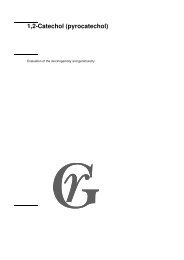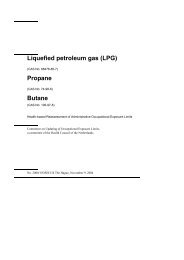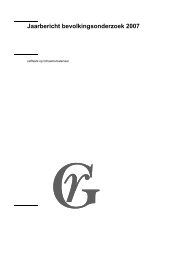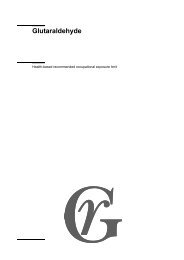Strychnine - Gezondheidsraad
Strychnine - Gezondheidsraad
Strychnine - Gezondheidsraad
Create successful ePaper yourself
Turn your PDF publications into a flip-book with our unique Google optimized e-Paper software.
Intraperitoneal LD 50<br />
values were 0.9-2.8 mg/kg bw in rats and 1.4-1.8 mg/kg<br />
bw in mice (ACG91, Lam68). There was no difference in intraperitoneal toxicity<br />
between the sulphate, benzoate, salicylate, and o-nitrobenzoate expressed in<br />
terms of their alkaloid content (Ray91). Subcutaneous LD 50<br />
values of 1.2-4.0,<br />
0.47, and 0.46 mg/kg bw have been reported for rats, mice, and dogs,<br />
respectively. <strong>Strychnine</strong> was more toxic to female than to male rats after oral,<br />
subcutaneous, or intraperitoneal administration, a difference that has been<br />
attributed to a higher rate of metabolism in males. Intravenous LD 50<br />
values were<br />
as low as 0.57-0.96 and 0.39 mg/kg bw in rats and guinea pigs, respectively<br />
(ACG91, NLM03, Ray91, Ric94, Sei82).<br />
The circadian toxicity of strychnine (sulphate) was evaluated at 6-hour<br />
intervals in male Ha/ICR mice, previously conditioned on a 12-hour light (from<br />
08.00 to 20.00 h) and 12-hour darkness schedule in a controlled environment.<br />
The highest acute lethality was observed in animals exposed during the light<br />
phase (at 18.00 h), whereas the lowest toxicity was observed in animals exposed<br />
during the dark phase (dose resulting in 50% acute lethality 1.57±0.12 and<br />
1.84±0.20 mg/kg bw, respectively) (Pie77).<br />
In vitro [ 3 H]-strychnine binding was decreased by 38 and 34% in the medulla<br />
and spinal cord, respectively, of 24-month-old rats compared to 2-month-old<br />
rats. Comparison of these age groups after intraperitoneal injection of strychnine<br />
of 1.75 mg/kg bw showed that senescent animals had a higher incidence of<br />
seizures and mortality (with faster onset times) compared to young animals<br />
(seizures 6/8 vs. 0/8, mortality 5/8 vs. 0/8). These differences may be attributed<br />
to age-related changes in glycinergic neurotransmission (Hun89). The findings<br />
contrast with data on strychnine poisoning in humans.<br />
The ED 50<br />
* for convulsions is remarkably close to the LD 50<br />
. In male COBS-<br />
CDI mice, the intraperitoneal LD 50<br />
was 1.34 mg/kg, whereas the intraperitoneal<br />
ED 50<br />
for both clonic and tonic convulsions was 1.24 mg/kg bw (Mac77).<br />
Following single subcutaneous administration of strychnine doses of 0.75, 1.25,<br />
and 1.50 mg/kg bw to adult CBA mice, convulsions developed in 8/20, 19/20,<br />
and 21/21 animals, respectively, with an average latency time ranging from 6.1<br />
to 10.3 minutes. Death occurred in 4/20, 17/20, and 19/21 mice, respectively. No<br />
sex difference was observed (Man87). <strong>Strychnine</strong>, intraperitoneally administered<br />
at 0.5-4 mg/kg bw, dose-dependently produced tonic seizures in male ‘albino<br />
mice’. The strychnine seizures in mice were potentiated by enhancement of<br />
noradrenergic neurotransmission (Ama94).<br />
* ED 50<br />
: dose at which a described effect is found in 50% of the exposed animals or at which the effect is changed by<br />
up to 50% compared to the control value.<br />
111-10 Health-based Reassessment of Administrative Occupational Exposure Limits


